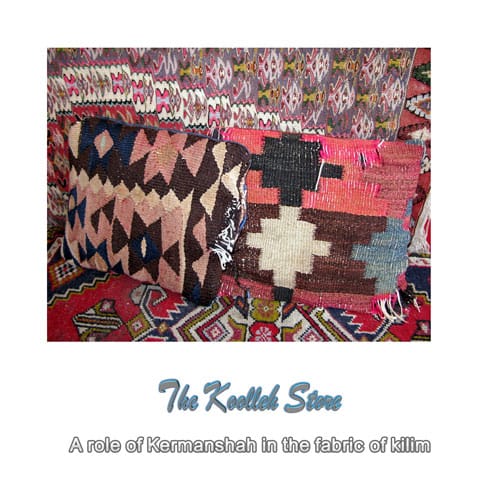A role of Kermanshah in the fabric of kilim

Every hand with any taste plays a desired role on it and it emerges from the art of Kermanshahi industrial weavers that every thread and every fabric is mixed with passion, love and art. A type of underlay that the carpet has evolved from, and this is the reason for its ancient history, which dates back to the years before Christ. As soon as man began to weave. Knitting for tunics and knitting for underwear.
The kilim is removed from the taro fabric and the knots are mixed together. A kilim means a lint-free carpet that is woven with the art of the finger and the blood of the heart and soul so that it can circulate in the world markets and Iranians and I can be proud of it. The kilim is no longer limited to village houses and nomadic tents, tourists who come to Kermanshah take the kilim with them as a souvenir and decorate their houses with it.
The yarn is made of silk and wool or hemp, it is either vertical or horizontal, but it has many uses. It can be used as a mat or a rug, or it can be hung on the wall to decorate the house; Even today, it can be used for sofa covers and decorative items.
In kilim weaving, the pattern has little application and the role-playing is usually done mentally, its design and color are specific to the area where it is woven; These designs in Kermanshah include the role of otters, fairy paws, ducks, human and animal motifs, sparrows and trees and various flocks.
Kilim weaving is the handicraft of many provinces of the country, but Kermanshah kilim and especially Harsin kilim is world famous and its design and quality are well-known. Perhaps the development of livestock and the abundance of high quality wool is one of the reasons for the popularity of this region.
Familiarity with the weaving process of the kilim and the effort that goes into its legs is necessary to know the value of this handicraft. The first stage of weaving the kilim is weaving. For this purpose, after selecting, first two strands of rope are tied at the desired intervals under the kilim weaving, and then the cotton thread that has already been shot at the right or left end of the knot is tied. Is beaten.
The ball of yarn is then passed from the back of the first gutter and from the front of the second gutter, and is carried to the back from the top of the gutter and taken out of the gutter. After squatting, it is time to close Kojvir; Kojvir is a cylindrical piece of wood with a diameter of about four centimeters and a length equivalent to the width of a kilim.
The weaving step is done before the weaving of the kilim and allows the weaver to perform the weaving operation more quickly. After the weaving is finished, it is necessary to make sure that the run-down weaves remain in place, because during weaving, problems will occur due to the impact on the woven part. In the meantime, some kilims are also made in embossed form and have their own fans.
Kilim weaving will never fade from the history of Kermanshah art and culture, and today young people learn the techniques of this handicraft by learning its methods from their families and participating in training classes, and take a step towards passing it on to future generations.
The Deputy Minister of Handicrafts of the General Directorate of Cultural Heritage, Handicrafts and Tourism of Kermanshah Province talks about the global fame of Kermanshah kilims and its extensive exports to other countries.
Nusratullah Sepehr, referring to the old history of kilim weaving in the province, said: Kilim weaving is more common in the cities of Harsin, Gilan-e-Gharb and Javanrood and its role plan is specific to the region.
He added: Glim is usually woven from goat and sheep wool, which is resistant to environmental factors and animals such as snakes and scorpions. Kermanshah kilim is exported to other countries and has a special place in international booths.
Sepehr reminded: Currently, between 3,000 and 4,000 people in the province are engaged in the art of kilim weaving.
A prominent Hersini kilim weaver also believes that kilims have maintained their position among the people and have many fans in domestic and foreign markets.
Hossein Khani said: Kilim is one of the ancient Iranian handicrafts that dates back to several thousand years BC; The most famous kilim of Kermanshah is related to Harsin city and especially the cold villages of Hossein Khani and Pariveh.
He considered kilim as a kind of lint-free carpet that is woven from fleece and has many decorative uses.
According to this Kermanshahi artist, the main designs of Hersin kilim include Mel Chafteh, crystal flowers, pea flowers, butt flowers, animal motifs, human motifs, doll flowers, strawberry flowers, samovar flowers, sparrow and tree motifs, ducks, owls and crabs. .
Hossein Khani spoke about the interest of young people in teaching the art of kilim weaving and added: Today, young people learn this art from their elders or receive the necessary training through handicrafts and tourism.
He pointed out about the process of weaving kilims: after preparing wool and turning it into yarn, they dye it with vegetable dyes, and then they prepare a carpet-like pattern and weave the kilim.
The kilim weaver continued: Currently, most kilim weavers do not have any problems in terms of insurance and are covered by social security services. Certainly, government financial support and providing facilities to those interested is an effective step towards the prosperity of this handicraft and art of Kermanshah.

